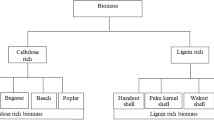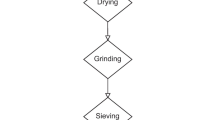Abstract
Feedstock heterogeneity is a fundamental obstacle to cost-competitive biobased products. Agricultural products like corn stover have anatomical components that vary in their chemical composition, mechanical properties, structure, and response to chemical and biological treatments. A technique that can enrich streams in select anatomical fractions would allow a tailored deconstruction approach to increase overall process efficiency. Air classification can be leveraged for such refining; however, fundamental characterization and understanding of the particle properties that underly the physics of air classification are only modestly documented. Here, we determine fundamental particle properties including mass-to-area ratio, drag coefficient, and partition velocity that describe how anatomical tissues of corn stover behave during air classification. Mass-to-area ratios of anatomical tissues vary by nearly two orders of magnitude from 2.3 mg/mm2 for cob to 0.04 mg/mm2 for leaf. Drag coefficients of longer, fibrous materials (i.e., rind, husk, and sheath) are shown to correlate with particle area (p-value < 0.001) whereas granular tissues (i.e., cob, pith, and leaf) correlate better with mass-to-area ratio (p-values < 0.001). When compared to experimental observations, a simulated two-stage air classification and size reduction scenario predicts the overall partitioning of anatomical tissues within 15% for pith, husk, rind, and cob tissues. The model predicts an air-classified fraction preferentially enriched in cob (purity = 20%), rind (purity = 74%), and pith (purity = 4.5%) with a mass yield of 47%. Empirical relations for these properties can be used to predict the partitioning of corn stover during air classification based on anatomical type and size.








Similar content being viewed by others
Data availability
Raw data for area and mass of corn stover particles are provided with this manuscript.
References
Sharma B, Larroche C, Dussap C-G (2020) Comprehensive assessment of 2G bioethanol production. Bioresour Technol 313:123630. https://doi.org/10.1016/j.biortech.2020.123630
Zhao Y, Damgaard A, Christensen TH (2018) Bioethanol from corn stover – a review and technical assessment of alternative biotechnologies. Prog Energy Combust Sci 67:275–291. https://doi.org/10.1016/j.pecs.2018.03.004
Langholtz M, Stokes B, Eaton L (2016) 2016 billion-ton report: advancing domestic resources for a thriving bioeconomy (executive summary). Ind Biotechnol 12:282–289. https://doi.org/10.1089/ind.2016.29051.doe
Morrison TA, Jung HG, Buxton DR, Hatfield RD (1998) Cell-wall composition of maize internodes of varying maturity. Crop Sci 38:455–460. https://doi.org/10.2135/cropsci1998.0011183X003800020031x
Duguid KB, Montross MD, Radtke CW, Crofcheck CL, Wendt LM, Shearer SA (2009) Effect of anatomical fractionation on the enzymatic hydrolysis of acid and alkaline pretreated corn stover. Bioresour Technol 100:5189–5195. https://doi.org/10.1016/j.biortech.2009.03.08
Crofcheck CL, Montross MD (2004) Effect of corn stover fraction on glucose production using enzymatic hydrolysis. Trans ASAE 47:841–844. https://doi.org/10.13031/2013.16081
Montross MD, Crofcheck CL (2004) Effect of stover fraction and storage method on glucose production during enzymatic hydrolysis. Bioresour Technol 92:269–274. https://doi.org/10.1016/j.biortech.2003.09.007
Williams DL, Crowe JD, Ong RG, Hodge DB (2017) Water sorption in pretreated grasses as a predictor of enzymatic hydrolysis yields. Bioresour Technol 245:242–249. https://doi.org/10.1016/j.biortech.2017.08.200
Li M, Yan G, Bhalla A, Maldonado-Pereira L, Russell PR, Ding S-Y, Mullet JE, Hodge DB (2018) Physical fractionation of sweet sorghum and forage/energy sorghum for optimal processing in a biorefinery. Ind Crops Prod 124:607–616. https://doi.org/10.1016/j.indcrop.2018.07.002
Sievers DA, Kuhn EM, Thompson VS, Yancey NA, Hoover AN, Resch MG, Wolfrum EJ (2020) Throughput, reliability, and yields of a pilot-scale conversion process for production of fermentable sugars from lignocellulosic biomass: a study on feedstock ash and moisture. ACS Sus Chem Eng 8:2008–2015. https://doi.org/10.1021/acssuschemeng.9b06550
Emerson RM, Hernandez S, Williams CL, Lacey JA, Hartley DS (2018) Improving bioenergy feedstock quality of high moisture short rotation woody crops using air classification. Biomass Bioenergy 117:56–62. https://doi.org/10.1016/j.biombioe.2018.07.015
Lacey JA, Aston JE, Westover TL, Cherry RS, Thompson DN (2015) Removal of introduced inorganic content from chipped forest residues via air classification. Fuel 160:265–273. https://doi.org/10.1016/j.fuel.2015.07.100
Duke University (1993) Air classification theory and design for municipal solid waste processing - final report. Report number EGG-EP-10715. https://doi.org/10.2172/6526810
Bartlett JD, Vesilind PA (1983) The effect of moisture on air classification of municipal solid waste. Waste Manage Res 1:347–357. https://doi.org/10.1016/0734-242X(83)90038-1
Everett Jess W, Peirce JJ (1989) Variable injection active-pulse air classification. J Environ Eng 115:395–408. https://doi.org/10.1061/(ASCE)0733-9372(1989)115:2(395)
Peirce JJ, Vesilind PA, McNabb M (1983) Predicting air classifier performance. J Energy Eng 109:7–16. https://doi.org/10.1061/(ASCE)0733-9402(1983)109:1(7)
Everett JW, Peirce JJ (1990) The development of pulsed flow air classification theory and design for municipal solid waste processing. Resour Conserv Recycl 4:185–202. https://doi.org/10.1016/0921-3449(90)90001-K
Bootsma JA, Shanks BH (2005) Hydrolysis characteristics of tissue fractions resulting from mechanical separation of corn stover. Appl Biochem Biotechnol 125:27–39. https://doi.org/10.1385/ABAB:125:1:027
Thompson VS, Lacey JA, Hartley D, Jindra MA, Aston JE, Thompson DN (2016) Application of air classification and formulation to manage feedstock cost, quality and availability for bioenergy. Fuel 180:497–505. https://doi.org/10.1016/j.fuel.2016.04.040
Weiss ND, Farmer JD, Schell DJ (2010) Impact of corn stover composition on hemicellulose conversion during dilute acid pretreatment and enzymatic cellulose digestibility of the pretreated solids. Bioresour Technol 101:674–678. https://doi.org/10.1016/j.biortech.2009.08.082
Lacey JA, Emerson RM, Thompson DN, Westover TL (2016) Ash reduction strategies in corn stover facilitated by anatomical and size fractionation. Biomass Bioenergy 90:173–180. https://doi.org/10.1016/j.biombioe.2016.04.006
Li Z, Zhai H, Zhang Y, Yu L (2012) Cell morphology and chemical characteristics of corn stover fractions. Ind Crops Prod 37:130–136. https://doi.org/10.1016/j.indcrop.2011.11.025
Miranda I, Gominho J, Mirra I, Pereira H (2012) Chemical characterization of barks from Picea abies and Pinus sylvestris after fractioning into different particle sizes. Ind Crops Prod 36:395–400. https://doi.org/10.1016/j.indcrop.2011.10.035
Williams CL, Emerson RM, Hernandez S, Klinger JL, Fillerup EP, Thomas BJ (2018) Preprocessing and hybrid biochemical/thermochemical conversion of short rotation woody coppice for biofuels. Front Energy Res 6:74
Bridgeman TG, Darvell LI, Jones JM, Williams PT, Fahmi R, Bridgwater AV, Barraclough T, Shield I, Yates N, Thain SC, Donnison IS (2007) Influence of particle size on the analytical and chemical properties of two energy crops. Fuel 86:60–72. https://doi.org/10.1016/j.fuel.2006.06.022
Li C, Aston JE, Lacey JA, Thompson VS, Thompson DN (2016) Impact of feedstock quality and variation on biochemical and thermochemical conversion. Renew Sust Energy Rev 65:525–536. https://doi.org/10.1016/j.rser.2016.06.063
Cousins DS, Otto WG, Rony AH, Pedersen KP, Aston JE, Hodge DB (2022) Near-infrared spectroscopy can predict anatomical abundance in corn stover. Front Energy Res 10:836690. https://doi.org/10.3389/fenrg.2022.836690
Hu H, Westover TL, Cherry R, Aston JE, Lacey JA, Thompson DN (2017) Process simulation and cost analysis for removing inorganics from wood chips using combined mechanical and chemical preprocessing. BioEnergy Res 10:237–247. https://doi.org/10.1007/s12155-016-9794-3
Bilanski WK, Lai R (1965) Behavior of threshed materials in a vertical wind tunnel. Trans ASAE 8:411–0413. https://doi.org/10.13031/2013.40533
Farran IG, Macmillan RH (1979) Grain-Chaff separation in a vertical air stream. J Agric Eng Res 24:115–129. https://doi.org/10.1016/0021-8634(79)90046-5
Smith RD, Liljedahl JB, Peart RM, Doering OC, Sahm WC (1984) Development and evaluation of a cob salvaging system. Trans ASAE 27:590–0596. https://doi.org/10.13031/2013.32834
Smith RD, Stroshine RL (1985) Aerodynamic separation of cobs from corn harvest residues. Trans ASAE 28:893–0897. https://doi.org/10.13031/2013.32358
Hartmann H, Böhm T, Daugbjerg Jensen P, Temmerman M, Rabier F, Golser M (2006) Methods for size classification of wood chips. Biomass Bioenergy 30:944–953. https://doi.org/10.1016/j.biombioe.2006.06.010
Igathinathane C, Pordesimo LO, Columbus EP, Batchelor WD, Methuku SR (2008) Shape identification and particles size distribution from basic shape parameters using ImageJ. Comput Electron Agric 63:168–182. https://doi.org/10.1016/j.compag.2008.02.007
Igathinathane C, Melin S, Sokhansanj S, Bi X, Lim CJ, Pordesimo LO, Columbus EP (2009) Machine vision based particle size and size distribution determination of airborne dust particles of wood and bark pellets. Powder Technol 196:202–212. https://doi.org/10.1016/j.powtec.2009.07.024
Igathinathane C, Pordesimo LO, Columbus EP, Batchelor WD, Sokhansanj S (2009) Sieveless particle size distribution analysis of particulate materials through computer vision. Comput Electron Agric 66:147–158. https://doi.org/10.1016/j.compag.2009.01.005
Guo Q, Chen X, Liu H (2012) Experimental research on shape and size distribution of biomass particle. Fuel 94:551–555. https://doi.org/10.1016/j.fuel.2011.11.041
Gil M, Teruel E, Arauzo I (2014) Analysis of standard sieving method for milled biomass through image processing. Effects of particle shape and size for poplar and corn stover. Fuel 116:328–340. https://doi.org/10.1016/j.fuel.2013.08.011
Lu Z, Hu X, Lu Y (2017) Particle morphology analysis of biomass material based on improved image processing method. Int J Anal Chem 2017:5840690. https://doi.org/10.1155/2017/5840690
Chaloupková V, Ivanova T, Krepl V (2019) Particle size and shape characterization of feedstock material for biofuel production. Agron Res 17:1861–1873. https://doi.org/10.15159/ar.19.152
Chinga G (2002) Shape descriptors. https://imagej.nih.gov/ij/plugins/descriptors.html
Haider A, Levenspiel O (1989) Drag coefficient and terminal velocity of spherical and nonspherical particles. Powder Technol 58:63–70. https://doi.org/10.1016/0032-5910(89)80008-7
Vesilind PA (1980) The Rosin-Rammler particle size distribution. Resour Recov Conserv 5:275–277. https://doi.org/10.1016/0304-3967(80)90007-4
Lisowski A, Matkowski P, Dąbrowska M, Piątek M, Świętochowski A, Klonowski J, Mieszkalski L, Reshetiuk V (2020) Particle size distribution and physicochemical properties of pellets made of straw, hay, and their blends. Waste Biomass Valori 11:63–75. https://doi.org/10.1007/s12649-018-0458-8
Bitra VSP, Womac AR, Yang YT, Miu PI, Igathinathane C, Chevanan N, Sokhansanj S (2011) Characterization of wheat straw particle size distributions as affected by knife mill operating factors. Biomass Bioenerg 35:3674–3686. https://doi.org/10.1016/j.biombioe.2011.05.026
Bitra VSP, Womac AR, Yang YT, Miu PI, Igathinathane C, Sokhansanj S (2009) Mathematical model parameters for describing the particle size spectra of knife-milled corn stover. Biosyst Eng 104:369–383. https://doi.org/10.1016/j.biosystemseng.2009.08.007
Gil M, Arauzo I (2014) Hammer mill operating and biomass physical conditions effects on particle size distribution of solid pulverized biofuels. Fuel Process Technol 127:80–87. https://doi.org/10.1016/j.fuproc.2014.06.016
Sluiter AD, Hames BR, Ruiz R, Scarlata C, Sluiter J, Templeton DW, Crocker D (2008) Determination of structural carbohydrates and lignin in biomass. National Renewable Energy Laboratory Technical Report NREL/TP-510-42618; National Renewable Energy Laboratory, Golden, CO, 2012
Tran-Cong S, Gay M, Michaelides EE (2004) Drag coefficients of irregularly shaped particles. Powder Technol 139:21–32. https://doi.org/10.1016/j.powtec.2003.10.002
Gudavalli C, Bose E, Donohoe BS, Sievers DA (2020) Real-time biomass feedstock particle quality detection using image analysis and machine vision. Biomass Conv Biorefinery. https://doi.org/10.1007/s13399-020-00904-w
Johansson R, Evertsson M (2012) CFD simulation of a gravitational air classifier. Miner Eng 33:20–26. https://doi.org/10.1016/j.mineng.2012.01.007
Altuhafi FN, Coop MR (2011) Changes to particle characteristics associated with the compression of sands. Géotechnique 61:459–471. https://doi.org/10.1680/geot.9.P.114
Almeida ED, Spogis N, Taranto OP, Silva MA (2019) Theoretical study of pneumatic separation of sugarcane bagasse particles. Biomass Bioenergy 127:105256
Funding
This material is based upon work supported by the US Department of Energy’s Office of Energy Efficiency and Renewable Energy (EERE) Bioenergy Technologies Office (BETO) and FOA-0002029 under the Award Number DE-EE0008907 “Enhanced Feedstock Characterization and Modeling to Facilitate Optimal Preprocessing and Deconstruction of Corn Stover.”
Author information
Authors and Affiliations
Contributions
DSC developed the theoretical framework, designed and carried out the experimental work, and drafted the manuscript. AHR carried out experimental work in air classification. WGO assisted with experimental work sorting anatomical fractions of corn stover. KPP carried out experimental work in sieving and manual fractionation. SH carried out experimental work in material production. JAL helped conceive of the framework and provided insight into the experiments. JEA coordinated material delivery and helped conceive of the theoretical framework. DBH oversaw the project, helped conceive the theoretical framework, provided guidance on manuscript storyboarding, and edited the manuscript.
Corresponding author
Ethics declarations
Ethics approval
Not applicable.
Competing interests
The authors declare no competing interests.
Additional information
Publisher's note
Springer Nature remains neutral with regard to jurisdictional claims in published maps and institutional affiliations.
Supplementary Information
Below is the link to the electronic supplementary material.
Rights and permissions
Springer Nature or its licensor holds exclusive rights to this article under a publishing agreement with the author(s) or other rightsholder(s); author self-archiving of the accepted manuscript version of this article is solely governed by the terms of such publishing agreement and applicable law.
About this article
Cite this article
Cousins, D.S., Rony, A.H., Otto, W.G. et al. Predictive models enhance feedstock quality of corn stover via air classification. Biomass Conv. Bioref. (2022). https://doi.org/10.1007/s13399-022-03307-1
Received:
Revised:
Accepted:
Published:
DOI: https://doi.org/10.1007/s13399-022-03307-1




